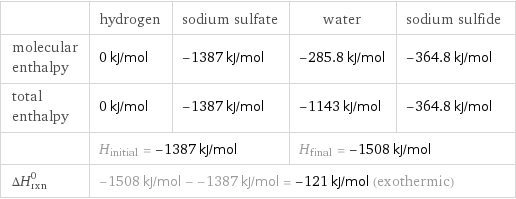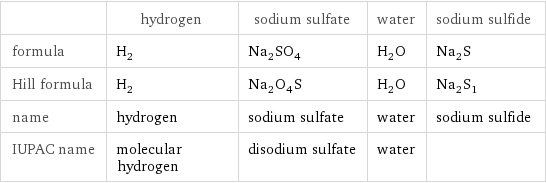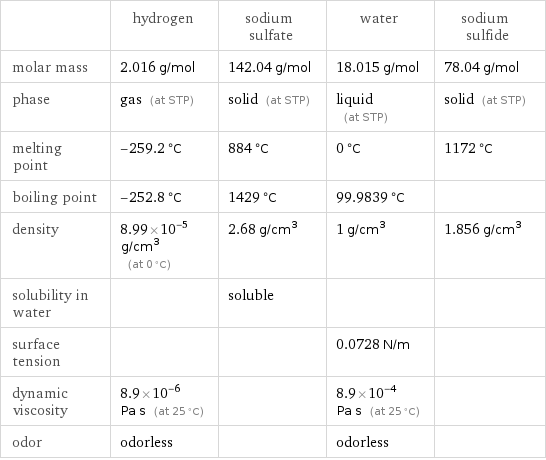Input interpretation

H_2 hydrogen + Na_2SO_4 sodium sulfate ⟶ H_2O water + Na_2S sodium sulfide
Balanced equation

Balance the chemical equation algebraically: H_2 + Na_2SO_4 ⟶ H_2O + Na_2S Add stoichiometric coefficients, c_i, to the reactants and products: c_1 H_2 + c_2 Na_2SO_4 ⟶ c_3 H_2O + c_4 Na_2S Set the number of atoms in the reactants equal to the number of atoms in the products for H, Na, O and S: H: | 2 c_1 = 2 c_3 Na: | 2 c_2 = 2 c_4 O: | 4 c_2 = c_3 S: | c_2 = c_4 Since the coefficients are relative quantities and underdetermined, choose a coefficient to set arbitrarily. To keep the coefficients small, the arbitrary value is ordinarily one. For instance, set c_2 = 1 and solve the system of equations for the remaining coefficients: c_1 = 4 c_2 = 1 c_3 = 4 c_4 = 1 Substitute the coefficients into the chemical reaction to obtain the balanced equation: Answer: | | 4 H_2 + Na_2SO_4 ⟶ 4 H_2O + Na_2S
Structures

+ ⟶ +
Names

hydrogen + sodium sulfate ⟶ water + sodium sulfide
Reaction thermodynamics
Enthalpy

| hydrogen | sodium sulfate | water | sodium sulfide molecular enthalpy | 0 kJ/mol | -1387 kJ/mol | -285.8 kJ/mol | -364.8 kJ/mol total enthalpy | 0 kJ/mol | -1387 kJ/mol | -1143 kJ/mol | -364.8 kJ/mol | H_initial = -1387 kJ/mol | | H_final = -1508 kJ/mol | ΔH_rxn^0 | -1508 kJ/mol - -1387 kJ/mol = -121 kJ/mol (exothermic) | | |
Gibbs free energy

| hydrogen | sodium sulfate | water | sodium sulfide molecular free energy | 0 kJ/mol | -1270 kJ/mol | -237.1 kJ/mol | -349.8 kJ/mol total free energy | 0 kJ/mol | -1270 kJ/mol | -948.4 kJ/mol | -349.8 kJ/mol | G_initial = -1270 kJ/mol | | G_final = -1298 kJ/mol | ΔG_rxn^0 | -1298 kJ/mol - -1270 kJ/mol = -28 kJ/mol (exergonic) | | |
Equilibrium constant
![Construct the equilibrium constant, K, expression for: H_2 + Na_2SO_4 ⟶ H_2O + Na_2S Plan: • Balance the chemical equation. • Determine the stoichiometric numbers. • Assemble the activity expression for each chemical species. • Use the activity expressions to build the equilibrium constant expression. Write the balanced chemical equation: 4 H_2 + Na_2SO_4 ⟶ 4 H_2O + Na_2S Assign stoichiometric numbers, ν_i, using the stoichiometric coefficients, c_i, from the balanced chemical equation in the following manner: ν_i = -c_i for reactants and ν_i = c_i for products: chemical species | c_i | ν_i H_2 | 4 | -4 Na_2SO_4 | 1 | -1 H_2O | 4 | 4 Na_2S | 1 | 1 Assemble the activity expressions accounting for the state of matter and ν_i: chemical species | c_i | ν_i | activity expression H_2 | 4 | -4 | ([H2])^(-4) Na_2SO_4 | 1 | -1 | ([Na2SO4])^(-1) H_2O | 4 | 4 | ([H2O])^4 Na_2S | 1 | 1 | [Na2S] The equilibrium constant symbol in the concentration basis is: K_c Mulitply the activity expressions to arrive at the K_c expression: Answer: | | K_c = ([H2])^(-4) ([Na2SO4])^(-1) ([H2O])^4 [Na2S] = (([H2O])^4 [Na2S])/(([H2])^4 [Na2SO4])](../image_source/d07bae7631dc28b7d544c948f702631f.png)
Construct the equilibrium constant, K, expression for: H_2 + Na_2SO_4 ⟶ H_2O + Na_2S Plan: • Balance the chemical equation. • Determine the stoichiometric numbers. • Assemble the activity expression for each chemical species. • Use the activity expressions to build the equilibrium constant expression. Write the balanced chemical equation: 4 H_2 + Na_2SO_4 ⟶ 4 H_2O + Na_2S Assign stoichiometric numbers, ν_i, using the stoichiometric coefficients, c_i, from the balanced chemical equation in the following manner: ν_i = -c_i for reactants and ν_i = c_i for products: chemical species | c_i | ν_i H_2 | 4 | -4 Na_2SO_4 | 1 | -1 H_2O | 4 | 4 Na_2S | 1 | 1 Assemble the activity expressions accounting for the state of matter and ν_i: chemical species | c_i | ν_i | activity expression H_2 | 4 | -4 | ([H2])^(-4) Na_2SO_4 | 1 | -1 | ([Na2SO4])^(-1) H_2O | 4 | 4 | ([H2O])^4 Na_2S | 1 | 1 | [Na2S] The equilibrium constant symbol in the concentration basis is: K_c Mulitply the activity expressions to arrive at the K_c expression: Answer: | | K_c = ([H2])^(-4) ([Na2SO4])^(-1) ([H2O])^4 [Na2S] = (([H2O])^4 [Na2S])/(([H2])^4 [Na2SO4])
Rate of reaction
![Construct the rate of reaction expression for: H_2 + Na_2SO_4 ⟶ H_2O + Na_2S Plan: • Balance the chemical equation. • Determine the stoichiometric numbers. • Assemble the rate term for each chemical species. • Write the rate of reaction expression. Write the balanced chemical equation: 4 H_2 + Na_2SO_4 ⟶ 4 H_2O + Na_2S Assign stoichiometric numbers, ν_i, using the stoichiometric coefficients, c_i, from the balanced chemical equation in the following manner: ν_i = -c_i for reactants and ν_i = c_i for products: chemical species | c_i | ν_i H_2 | 4 | -4 Na_2SO_4 | 1 | -1 H_2O | 4 | 4 Na_2S | 1 | 1 The rate term for each chemical species, B_i, is 1/ν_i(Δ[B_i])/(Δt) where [B_i] is the amount concentration and t is time: chemical species | c_i | ν_i | rate term H_2 | 4 | -4 | -1/4 (Δ[H2])/(Δt) Na_2SO_4 | 1 | -1 | -(Δ[Na2SO4])/(Δt) H_2O | 4 | 4 | 1/4 (Δ[H2O])/(Δt) Na_2S | 1 | 1 | (Δ[Na2S])/(Δt) (for infinitesimal rate of change, replace Δ with d) Set the rate terms equal to each other to arrive at the rate expression: Answer: | | rate = -1/4 (Δ[H2])/(Δt) = -(Δ[Na2SO4])/(Δt) = 1/4 (Δ[H2O])/(Δt) = (Δ[Na2S])/(Δt) (assuming constant volume and no accumulation of intermediates or side products)](../image_source/470425c1f2d5155c6d64faebe1f43adc.png)
Construct the rate of reaction expression for: H_2 + Na_2SO_4 ⟶ H_2O + Na_2S Plan: • Balance the chemical equation. • Determine the stoichiometric numbers. • Assemble the rate term for each chemical species. • Write the rate of reaction expression. Write the balanced chemical equation: 4 H_2 + Na_2SO_4 ⟶ 4 H_2O + Na_2S Assign stoichiometric numbers, ν_i, using the stoichiometric coefficients, c_i, from the balanced chemical equation in the following manner: ν_i = -c_i for reactants and ν_i = c_i for products: chemical species | c_i | ν_i H_2 | 4 | -4 Na_2SO_4 | 1 | -1 H_2O | 4 | 4 Na_2S | 1 | 1 The rate term for each chemical species, B_i, is 1/ν_i(Δ[B_i])/(Δt) where [B_i] is the amount concentration and t is time: chemical species | c_i | ν_i | rate term H_2 | 4 | -4 | -1/4 (Δ[H2])/(Δt) Na_2SO_4 | 1 | -1 | -(Δ[Na2SO4])/(Δt) H_2O | 4 | 4 | 1/4 (Δ[H2O])/(Δt) Na_2S | 1 | 1 | (Δ[Na2S])/(Δt) (for infinitesimal rate of change, replace Δ with d) Set the rate terms equal to each other to arrive at the rate expression: Answer: | | rate = -1/4 (Δ[H2])/(Δt) = -(Δ[Na2SO4])/(Δt) = 1/4 (Δ[H2O])/(Δt) = (Δ[Na2S])/(Δt) (assuming constant volume and no accumulation of intermediates or side products)
Chemical names and formulas

| hydrogen | sodium sulfate | water | sodium sulfide formula | H_2 | Na_2SO_4 | H_2O | Na_2S Hill formula | H_2 | Na_2O_4S | H_2O | Na_2S_1 name | hydrogen | sodium sulfate | water | sodium sulfide IUPAC name | molecular hydrogen | disodium sulfate | water |
Substance properties

| hydrogen | sodium sulfate | water | sodium sulfide molar mass | 2.016 g/mol | 142.04 g/mol | 18.015 g/mol | 78.04 g/mol phase | gas (at STP) | solid (at STP) | liquid (at STP) | solid (at STP) melting point | -259.2 °C | 884 °C | 0 °C | 1172 °C boiling point | -252.8 °C | 1429 °C | 99.9839 °C | density | 8.99×10^-5 g/cm^3 (at 0 °C) | 2.68 g/cm^3 | 1 g/cm^3 | 1.856 g/cm^3 solubility in water | | soluble | | surface tension | | | 0.0728 N/m | dynamic viscosity | 8.9×10^-6 Pa s (at 25 °C) | | 8.9×10^-4 Pa s (at 25 °C) | odor | odorless | | odorless |
Units
